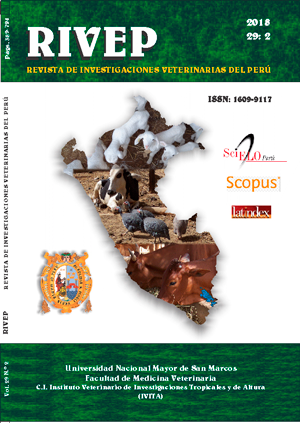Dynamics of the primary production and nutritive value of three tropical grasses (Melinis minutiflora, Setaria sphacelata and Brachiaria mutica) in three phenological stages
DOI:
https://doi.org/10.15381/rivep.v29i2.14494Keywords:
tropical grass, nutritional value, plant height, dry matter, crude protein, in vitro digestibility, phenological stateAbstract
The dynamics of primary production and nutritional value were evaluated based on the variation of dry matter yield, plant height, crude protein content, crude fibre, and in vitro digestibility of dry matter (DM) in three phenological stages (floral bud, start of flowering and seed maturation) of three species of tropical grasses: para grass (Brachiaria mutica), molasses grass (Melinis minutiflora) and South African pigeon grass (Setaria sphacelata). The study was conducted in the province of Oxapampa, Pasco region (Peru) using a statistical design of divided plots for the variable of production of aerial biomass and completely randomized blocks for the nutritional value of the forage. B. mutica had the highest average height (97 cm), followed by S. sphacelata (55 cm) and M. minutiflora (40 cm). The superiority in height of B. mutica was reflected in the highest cumulative dry matter production (8978 kg DM/ha) compared to S. sphacelata (5755 kg DM/ha) and M. minutiflora (4338 kg DM/ha). B. mutica and S. sphacelata maintained similar crude protein average (6.83 and 7.45%) and in vitro digestibility (72.36, 73.0%) and greater than those of M. minutiflora (5.83% and 69.6%, respectively). The phenological analysis revealed that S. sphacelata completes its phenological development in less time (7 months), followed by B. mutica (8 months) and M. minutiflora (9 months). The use of B. mutica and S. sphacelata instead of M. minutiflora is recommended due to its greater dry matter production capacity and better nutritional value.Downloads
Downloads
Published
Issue
Section
License
Copyright (c) 2018 Gilmar López A., Jimny Nuñez D., Lucrecia Aguirre T., Enrique Flores M.

This work is licensed under a Creative Commons Attribution-NonCommercial-ShareAlike 4.0 International License.
AUTHORS RETAIN THEIR RIGHTS:
a. Authors retain their trade mark rights and patent, and also on any process or procedure described in the article.
b. Authors retain their right to share, copy, distribute, perform and publicly communicate their article (eg, to place their article in an institutional repository or publish it in a book), with an acknowledgment of its initial publication in the Revista de Investigaciones Veterinarias del Perú (RIVEP).
c. Authors retain theirs right to make a subsequent publication of their work, to use the article or any part thereof (eg a compilation of his papers, lecture notes, thesis, or a book), always indicating the source of publication (the originator of the work, journal, volume, number and date).










